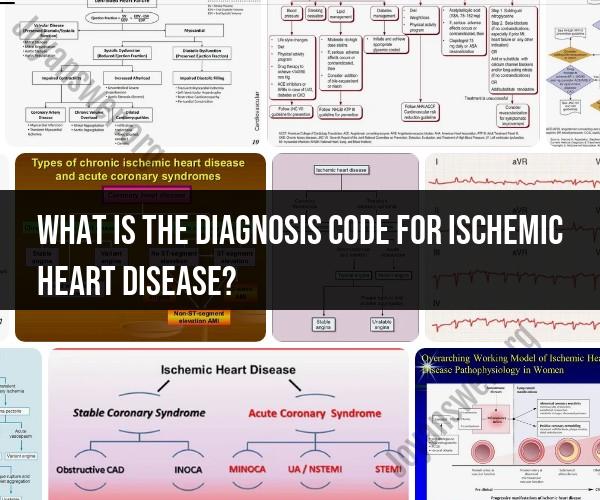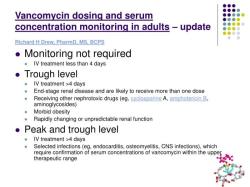What is the diagnosis code for ischemic heart disease?
The diagnosis code for ischemic heart disease in the International Classification of Diseases, Tenth Revision (ICD-10) is typically found under the category "I20-I25 - Ischemic heart diseases." This category includes a range of codes for various forms of ischemic heart disease, including angina pectoris and heart attacks (myocardial infarction). The specific code assigned depends on the patient's condition and clinical documentation. Here are some common ICD-10 codes for ischemic heart disease:
I20.0 - Unstable angina
- Used for cases of unstable angina, which is a type of chest pain that occurs at rest or with minimal exertion and is considered a medical emergency.
I21 - Acute myocardial infarction
- This code is used for cases of acute heart attack (myocardial infarction). Subcategories (e.g., I21.0, I21.1) and laterality codes may be used for more specific classification.
I22 - Subsequent ST elevation (STEMI) and non-ST elevation (NSTEMI) myocardial infarction
- These codes are used for follow-up or subsequent visits related to ST elevation myocardial infarction (STEMI) or non-ST elevation myocardial infarction (NSTEMI).
I23 - Certain current complications following acute myocardial infarction
- This code is used for complications that may arise after an acute myocardial infarction.
I24 - Other acute ischemic heart diseases
- This code is used for other types of acute ischemic heart diseases that do not fall under the previous categories.
Please note that these codes represent a subset of the possible ICD-10 codes related to ischemic heart disease. The specific code used in a patient's medical record will depend on the details of their condition, including the type of ischemic heart disease, any complications, and the clinical documentation provided by the healthcare provider. Accurate coding is crucial for medical billing and insurance purposes and for tracking and studying diseases and conditions. It is important to consult with a qualified medical coder or healthcare professional for precise coding.
Diagnosis Codes for Ischemic Heart Disease
Ischemic heart disease (IHD) is a condition that occurs when the blood supply to the heart muscle is reduced or blocked. This can damage or destroy heart muscle tissue and lead to a number of complications, including heart attack, heart failure, and arrhythmias.
There are a number of different diagnostic codes for IHD, depending on the specific type of IHD and the severity of the condition. Some of the most common diagnosis codes for IHD include:
- I20.9: Acute coronary syndrome, unspecified
- I21.0: Acute myocardial infarction (AMI), anterior wall
- I21.1: AMI, inferior wall
- I21.2: AMI, lateral wall
- I21.3: AMI, other specified wall
- I21.4: AMI, unspecified wall
- I21.9: AMI, unspecified
- I22: Other acute forms of ischemic heart disease
- I25.1: Atherosclerotic heart disease of native coronary artery
- I25.9: Chronic ischemic heart disease, unspecified
ICD-10 Codes for Ischemic Heart Disease
The International Classification of Diseases, 10th Revision (ICD-10) is a coding system that is used to classify and report diseases and other health problems. ICD-10 codes are used by healthcare providers, insurance companies, and public health agencies.
The ICD-10 codes for ischemic heart disease are the same as the diagnosis codes listed above. For example, the ICD-10 code for acute myocardial infarction (AMI) of the anterior wall is I21.0.
Understanding the Coding System for Heart Disease
The coding system for heart disease is complex and can be challenging to understand. However, it is important to have a basic understanding of the coding system in order to ensure that your medical records are accurate and complete.
When coding for heart disease, healthcare providers must consider a number of factors, including the specific type of heart disease, the severity of the condition, and any other relevant medical conditions. The coding system also includes codes for specific procedures and treatments that are used to treat heart disease.
Documenting and Reporting Ischemic Heart Disease
Healthcare providers must document and report ischemic heart disease accurately in order to ensure that patients receive the correct treatment and reimbursement for services.
When documenting IHD, it is important to include the following information:
- The type of IHD
- The severity of the condition
- Any other relevant medical conditions
- The patient's symptoms
- The results of any diagnostic tests
- The treatment plan
Coding Compliance and Accuracy for Heart Conditions
Coding compliance and accuracy are essential for ensuring that patients receive the correct treatment and reimbursement for services. Healthcare providers must follow the ICD-10 coding guidelines and use the correct codes for all heart conditions.
There are a number of resources available to help healthcare providers with coding compliance and accuracy. For example, the Centers for Medicare and Medicaid Services (CMS) has a website that provides information on ICD-10 coding for heart conditions.
By following the coding guidelines and using the correct codes, healthcare providers can help to ensure that their patients receive the best possible care.











